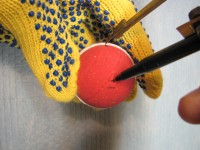I have kept a list of my favorite brands and models within those brands. There are many more brands and models that are enjoyable to carve but be aware there are models that are not “2 piece” construction. They are made with multiple covers, multiple layers and of course the wound rubber band. Since I lean toward the Titlest brand, I keep a list of Titlest models I avoid. They resist even the sharpest tools or have rubber bands. I’ve included them in the “Not Acceptable” category at the bottom.
An acquaintance named Tom Rhodes has a book that will provide inspiration for thinking inside AND outside the ball. The book also has an extensive list of ball characteristics for hundreds of balls.
Acceptable
- Titlest:
HP Tour
HP2 Tour
HP and a number
DT Distance
DT 2 Piece
HVC and a number
HVC Tour
HVC Distance
HVC Distance-L
HVC Soft Feel
HVC Spin
- Topflite:
Tour Edition
Tour-SD90
Infinity Awesome Distance
Infinity Absolutely Straight
XL2000 Exceptional Spin
XL2000 Super Titanium
XL3000 Super Feel
- MAXFLI:
Noodle Long and Soft
- Pinnacle:
Gold
Gold Spin
Gold Velocity
Gold – FX Long
Gold – FX Soft
Equalizer
Extreme
Performance
Power 392
392 LS
Pinnacle 90
332
384 90 Compression
Distance LS
Not Acceptable
- Titlest:
Anything with titanium
Tour Prestige
Tour Distance
Tour Distance SF
HP2 Distance
HP Distance
HP Eclipse
Pro V 1
Pro V 1*
DT So/Lo
DT Spin
Professional
DT and a number
NXT Tour
NXT Distance
Anything with “wound”









